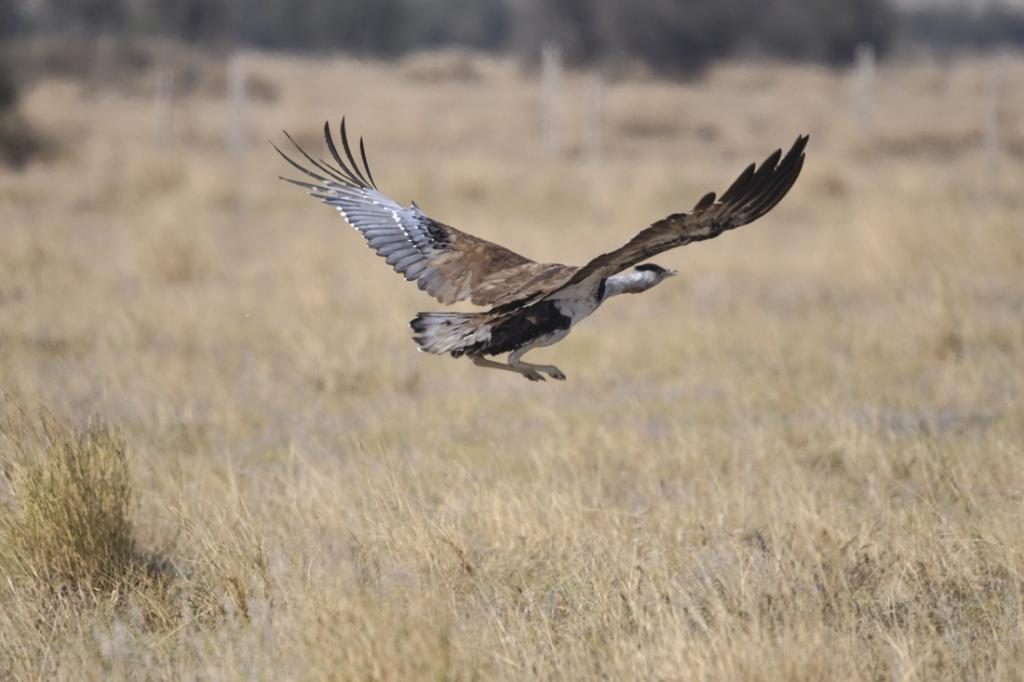Down To Earth speaks to wildlife biologist on 64 GIBs being counted by the Rajasthan Forest Department during its annual waterhole survey
 A Great Indian Bustard at Desert National Park, Rajasthan. Photo: iStock
A Great Indian Bustard at Desert National Park, Rajasthan. Photo: iStock
This past week brought good news for the bealeagured Great Indian Bustard (GIB), which was once in the running for becoming India’s National Bird, but is now fighting for survival.
The Rajasthan Forest Department conducted its annual ‘watrerhole survey’ and counted 64 GIBs in the state’s Jaisalmer district. While the numbers have generated a considerable amount of excitement, what does it mean for GIB conservation? Are conservation and breeding measures succeeding? Does the GIB have a fighting chance at survival?
Down To Earth put these questions to wildlife biologist Sumit Dookia, Honorary Scientific Advisor to ERDS Foundation, a non-profit working with local communities for the conservation of GIB. Dookia has worked on the GIB alongwith several other species of the Thar. Edited excerpts:
Rajat Ghai (RG): What is the waterhole method used by authorities to conduct the census of GIBs? What are its advantages over other estimation methods?
Sumit Dookia (SD): The waterhole method of enumerating wildlife populations is basically a direct or head count process. Skilled workers and volunteers sit near a water body — natural or human-made — during peak summer season and count all animals that visit it within a fixed timeframe.
Generally, this timeframe is a continuous 24-hour period. It is assumed that all animals in the vicinity will visit the waterbody in order to drink water at least once during this 24-hour period.
The method has many pros and cons. Pros include a direct count done with minimum expense and immediate results. The cons are that it allows greater freedom of decision-making to the enumerator. For instance, if an animal comes to drink water more than once, the enumerator can keep counting or take a call on whether to include it in the count again. This method is mostly used for large mammals.
The best advantage of this method is that it gives absolute numbers without any analytical process. The forest department uses it for conducting population counts (not censuses). These counts can help reveal wildlife population trends over the years.
The waterhole method, while not very relevant in today’s age of advanced tech and statistics, is still good enough for forest departments, who can use the data collected through it to understand as to whether wildlife numbers are declining or spiking.
RG: What could have caused the increase in the number of GIBs?
SD: The waterhole census for the last two years was cancelled due to rain. Therefore, the increase or decrease in GIB numbers cannot be ascertained by the current figure.
What I can say is that the forest department has been doing a commendable job since the last 4-5 years with respect to habitat management inside the Desert National Park enclosures. A few local organisations, communities and even Panchayat institutions are playing a pivotal role in increasing suitable habitats for the GIB outside protected areas. All these cumulatively helped in increasing protection for the GIB population.
RG: The Thar is receiving more rain now due to the climate crisis. How will that shape the GIB’s chances of survival?
SD: It is true that rain and mean annual rainfall in western Rajasthan have increased in the last 5-6 decades because of climatic changes. More rain extends the distribution range of many elements of biodiversity and that is not good for native animals and plants of the Thar.
However, though the GIB depends on a wide range of animals and plants for survival, there is no imminent threat to it because of the changing climate of the Thar.
RG: What, in your view, is the total number of GIBs in India at the moment, including birds in Rajasthan, Gujarat and the Deccan states?
SD: Numbers — whether of species that are critically endangered or are not at risk — always attract attention. There have been no population estimates of the GIB done since 2018 when the Wildlife Institute of India estimated its numbers to be a maximum of 150 individuals.
Through field volunteers and intelligence gathered from various sources, we can say there are around 90-100 individuals in Rajasthan and only four females in Gujarat since the last 2-3 yrs. The Deccan states together may have 5-8 GIBs.
As six years have passed since the last population estimate, there is an urgent need to know the present status of the GIB population. It is also important to expedite conservation efforts.
We are a voice to you; you have been a support to us. Together we build journalism that is independent, credible and fearless. You can further help us by making a donation. This will mean a lot for our ability to bring you news, perspectives and analysis from the ground so that we can make change together.



















































